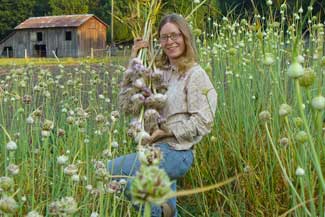Garlic May Prevent Hip Osteoarthritis
Williams et al. (2010) reported that eating allium vegetables may prevent hip osteoarthritis (OA). Alliums include tasty vegetables such as garlic, onions, shallots, chives and leeks.
Osteoarthritis is a debilitating joint disorder affecting working age and older adults. It causes joint stiffness, joint pain and loss of function. People who suffer from this disorder may find it hard or painful to bend over, put on shoes or participate in normal activities (like gardening or growing garlic). Major risk factors for hip osteoarthritis are aging, being a Caucasian woman (Black and Asian women have a decreased risk) and being overweight.
Picture: Patty plans to eat several hundred servings of fresh garlic for dinner! No wonder she's flexible enough to hold up those large bunches of garlic with her knee.
Osteoarthritis develops when injury or inflammation in a joint causes cartilage tissue to break down faster than it is repaired. This gradually results in a loss of protective cartilage on the ends of the bones. Due to this, osteoarthritis is commonly known as 'wear and tear' arthritis. Cartilage is a rubbery and flexible tissue that reduces friction and acts as a shock absorber in joints. Healthy cartilage keeps the joints bouncy and pain free.
In William's study, 1o68 healthy female twins (age 46-77) were scanned for osteoarthritis with a radiograph, had body mass index (BMI) calculated and completed food frequency, lifestyle and activity questionnaires. Twin studies are interesting because two people with the same initial genetic profile can be compared. This makes it easier to separate out the difference between lifestyle choices and genetics in disease risk. Genetic profiles can change as people age due to the influence of environment on genes, a process discussed in my epigenetics and garlic page.
After other factors were taken into account, a diet containing more garlic, onions and other alliums protected women against hip osteoarthritis.
Why alliums may protect against arthritis: Healthy joints depend on healthy cartilage, the flexible 'molding' that holds the joints together. Inflammation can cause cartilage and joint destruction. One inflammatory compound, Interleukin-1 (IL-1), triggers the destruction of articular (joint) cartilage. IL-1 promotes the expression and activation of matrix-degrading metalloproteinase enzymes such as matrix metalloproteinases (MMPs). MMPs are strongly involved in the tissue destruction and inflammation caused by arthritis and tumors.
Alliums contain a sulfur compound, diallyl disulphide, which dose dependently represses the expression of MMP in chondrocyte-like cells. In simpler terms, as beneficial diallyl disulphide increases, concentrations of harmful MMP decrease. The reduction in MMPs helps prevent chronic cartilage destruction and arthritis.
A recent study found that three isolated garlic compounds; caffeic acid, S-allyl cysteine, and uracil; inhibited expression of MMP and NF-κB signaling (Kim et al. 2013). The same study showed that garlic may hinder skin aging.
Sulfur compounds in garlic also reduces inflammation; excess inflammation contributes to arthritis and joint damage. Sulfur chemicals in garlic inhibit NF-κB which helps prevent inflammation and arthritis (Ban et al. 2009).
A cell culture experiment found that the garlic compound, diallyl sulfide (DAS), prevents IL-1B and MSU crystal induced COX-2 upregulation in synovial cells and chondrocytes (both from people with osteoarthritis). DAS also treats crystal induced synovitis through a mechanism involving NF-κB. In other words, DAS reduces inflammation while helping to prevent crystal induced synovitis.
Take home message: Garlic consumption may help prevent hip osteoarthritis.
By Susan Fluegel PHD
References:
- Ban JO, Oh JH, Kim TM, Kim DJ, Jeong HS, Han SB, Hong JT. Anti-inflammatory and arthritic effects of thiacremonone, a novel sulfur compound isolated from garlic via inhibition of NF-kappaB. Arthritis Res Ther. 2009;11:R145. Pubmed. doi: 10.1186/ar2819 (full text)
- Kim SR, Jung YR, An HJ, Kim DH, Jang EJ, Choi YJ, Moon KM, Park MH, Park CH, Chung KW, Bae HR, Choi YW, Kim ND, Chung HY. Anti-wrinkle and anti-inflammatory effects of active garlic components and the inhibition of MMPs via NF-κB signaling. PLoS One. 2013; 16;8:e73877. Pubmed. doi: 10.1371/journal.pone.0073877 (full text)
- Lee HS, Lee CH, Tsai HC, Salter DM. Inhibition of cyclooxygenase 2 expression by diallyl sulfide on joint inflammation induced by urate crystal and IL-1beta. Osteoarthritis Cartilage. 2009;17:91-9. Pubmed. doi: 10.1016/j.joca.2008.05.010
- Williams FM, Skinner J, Spector TD, Cassidy A, Clark IM, Davidson RM, MacGregor AJ. Dietary garlic and hip osteoarthritis: evidence of a protective effect and putative mechanism of action. BMC Musculoskeletal Disorders 2010;11:28. Pubmed. doi: 10.1186/1471-2474-11-280 (full text)
